Buying a home is expensive enough, between sky-high home prices and mortgage rates. But the financial strain doesn’t stop at closing—and being a homeowner is more expensive than ever. It’s the lingering pain of hidden fees, which are making it more challenging to maintain a house.
Indeed, the average annual cost of owning and maintaining a single-family home in the U.S. is now more than $18,000 a year, which is 26% more now than compared to four years ago, according to a Bankrate study released Monday. These hidden costs include property taxes, homeowners insurance, home maintenance costs, as well as energy, internet, and cable bills.
“Homeownership is an important wealth-builder for many Americans, but it ain’t cheap,” Jeff Ostrowski, a Bankrate analyst, said in a statement. “These numbers show that the costs of owning a home are at the same level as buying a used car every year. While homeownership is worth the financial sacrifice, homeowners also need to be aware of the ongoing expenses that go along with owning property.”
What’s making homeownership so expensive
One of the biggest culprits behind the rising cost of homeownership is insurance. The cost of homeowner’s insurance has continued to climb the past few years, especially in coastal areas and those prone to extreme weather.
Nearly three-fourths of home insurance policyholders reported rate hikes in 2023, with more than one third of them saying their premiums increased 5% to 9.99%, according to results from a ValuePenguin survey of 2,035 U.S. consumers conducted in February. Already, more than one-third of policy holders say they’re struggling to afford their premiums this year.
“Inflation, combined with higher home values, has also resulted in increased property taxes and insurance premiums,” Matt Dunbar, senior vice president of the southeast with national lender Churchill Mortgage, tells Fortune. “Rising insurance costs are influenced by higher home values, increased construction expenses, and more frequent natural disasters. Together, these factors have made homeownership much more expensive than it was four years ago.”
Just to get an idea of how expensive home insurance has gotten, the average cost of homeowners insurance is $126 per month, or $1,516 per year, according to ValuePenguin. Among the states with the highest monthly insurance rates are Colorado ($242), Nebraska ($213), Texas ($211), Kansas ($189), Florida ($184), and California ($153). That’s just for an average-sized home of about 2,100 square feet. Of course, the rates fluctuate according to the amount of space and location.
“Everything is more expensive right now. Insurance is a big piece of most coastal states,”
Marilyn Wright, a global real-estate adviser at Premier Sotheby’s International Realty, tells Fortune. “It is really important to review the average temperatures for the area you are considering as it will be a crucial piece of the puzzle for expenses, heating, cooling, and [insurance].”
Other factors inflating the cost of homeownership include utility bills, maintenance fees, property taxes, and homeowners association fees. Homeowners association fees have gotten so costly in some areas—particularly Florida—that owners have been forced to drop the prices on their homes in order to get them to sell.
How hidden costs affect homeownership in the long run
To put it plainly, hidden costs make homeownership unaffordable for many people in the U.S. Even if you can afford your monthly mortgage payment, that’s not enough.
“Imagine having to fork out an extra $1,500 every month when you’re already stretching to afford your dream home. It’s enough to make anyone rethink their budget,” Angelica Ferguson VonDrak, a real-estate broker, tells Fortune. “For a lot of folks, it means tightening the belt in other areas or even questioning if owning a home is doable at all.”
According to Bankrate, the states with the most expensive homeownership costs include Hawaii, California, Massachusetts, New Jersey, and Connecticut. This is largely influenced by high home values, property taxes, and maintenance costs.
Maintenance costs can be one of those especially tricky line items to account for when buying a home since it’s not necessarily a fixed cost or easy to estimate. VonDrak suggests talking to your realtor about the maintenance a property may need since these costs can “be the highest expenditures you’ll face,” she says.
“Wood siding? That will likely need to be painted or stained regularly over the years. Gutters? You need to clean those on an annual basis. Heating/cooling systems need to be serviced annually. You get the picture,” VonDrak says. “If you let things go for too long, you could be facing much larger problems and more expensive repairs later.”
From a bird’s eye view, the rise in homeownership costs could also have long-term ramifications on the housing market as a whole. Indeed, the housing market may slow down as fewer people are able to afford homes, and more people may be at heightened risk of foreclosure with rising expenses, Dunbar says.
“In the long term, these sustained high costs could limit mobility,” Dunbar says. “People might choose to stay in their current homes to avoid the higher expenses associated with moving, potentially leading to stagnation in the housing market.”

